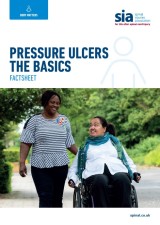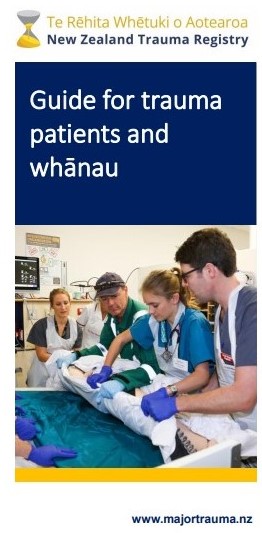Wishing everyone a safe and happy Christmas and New Year – Meri Kirihimete from the Healthify team.
Spinal cord injuries
Key points about spinal cord injuries
- Your spinal cord runs through the centre of your spine. Damage or trauma to your spinal cord leads to loss of movement, function or sensation below the site of the injury.
- The amount and type of function lost tends to relate to the level of your spinal cord where the damage occurred.
- The effects can vary widely, ranging from minor changes in sensation to complete paralysis.
- Severe damage to the spinal cord causes permanent damage.
- There are things you can do to help avoid or minimise secondary complications that can occur with long-term disability following spinal cord damage.

A spinal cord injury (SCI) is damage to your spinal cord that can disturb the flow of nerve signals between your brain and the rest of your body. This can lead to loss of movement, sensation or function below the injury site.
The extent of your SCI, and the symptoms you experience, relate to the spinal vertebrae (bones) where the injury occurred. There are 7 cervical vertebrae (C1 to C7) at the top of your spine, 12 thoracic vertebrae (T1 to T12) in the middle of your spine, and 5 lumbar vertebrae (L1 to L5) which attach to the sacral bone (the sacrum) and pelvis at the bottom of the spine.

Image credit: Depositphotos
SCIs can be caused by trauma, such as accidents or falls, or by diseases such as multiple sclerosis, spine infection, spinal canal stenosis or spinal tumours. The effects can vary widely, ranging from minor changes in sensation to complete paralysis.
Early intervention and rehabilitation are really important for recovery and improving your quality of life. Prioritising health and wellness is key to managing the challenges that come with an SCI.
The spinal cord contains the nerves that carry messages between your brain and the rest of your body. The cord passes through your neck and back. Damage to your spinal cord can occur when its blood and oxygen supply is interrupted and/or pressure is applied to it.
Frequent causes of spinal cord damage are traumatic accidents, such as motor vehicle incidents, falls, violence and sports activities. There are also many diseases that can cause spinal cord injury such as transverse myelitis, multiple sclerosis, cervical myelopathy, infections, tumours, and disturbance to the blood supply resulting in spinal stroke or infarction.
The symptoms experienced are different for everyone and depend on the level at which your spinal cord is damaged. They can include:
- loss of feeling or numbness
- loss of mobility (motor function)
- loss of bowel or bladder control
- loss of temperature control
- pain in your neck, back, hands and legs from nerve damage
- paralysis or difficulty with balance or walking
- stinging sensations
- difficulty breathing at higher levels near your neck.
A physical examination is often the first test that's performed. Your healthcare provider may assess your muscle tone, strength, reflexes and your ability to sense touch and pin-prick. Other common tests used to assist diagnosis include:
Spinal injuries can be diagnosed as:
- Complete – when your spinal cord is completely damaged and there is total loss of feeling and the ability to control movement below the injury.
- Incomplete – when there is some movement and/or sensation below the level of the injury.
Paralysis caused by spinal injury can result in either:
- paraplegia – where there is loss of sensory and/or motor function in your legs and trunk (depending on the level of the injury), or
- tetraplegia (also known as quadriplegia) – where there is loss of sensory and/or motor function from the neck down, including paralysis of both arms and legs.
Management of spinal cord injuries has 3 key phases.
1. Minimising further injury to your spinal cord
- If you suspect a spinal injury and need to perform first aid, don't move the injured person as permanent complications can result. Call 111 for emergency medical assistance.
- Keep the person's head, neck and back in a straight line and prevent unnecessary movement.
- Provide as much first aid as possible without moving the person's head or neck.
- If the person is wearing a helmet, don't remove it.
- In hospital, further steps will be taken to stabilise the spine. This can include traction or braces.
- Sometimes surgery is needed and any other injuries need to be treated.
2. Rehabilitation
- Spinal rehabilitation involves a multidisciplinary approach with the involvement of a spinal physician, spinal rehab nurse, physiotherapist, occupational therapist and social worker. Rehabilitation will be tailored to your mobility, daily activity needs and any nerve-related bladder and bowel dysfunction. It also aims to reduce health-related complications for the spinal cord injuries.
- This phase also usually includes counselling for both you and your loved ones to help the adjustment and recovery process.
3. Preventing and managing long-term complications
Health issues that may arise if you have a spinal cord injury include:
- lung infections
- urinary tract infections (UTI)
- kidney stones
- muscle spasm or spasticity (tightness from muscle contractions)
- pressure sores
- fluctuations in body temperature
- chronic pain
- erectile dysfunction in men and reduced sexual responses in women
- constipation
- depression and other mental health problems.
Talk to your healthcare provider about the best way to prevent and manage these conditions.
Autonomic dysreflexia (spinal hypertensive crisis)
Autonomic dysreflexia (AD) is a condition where there’s a sudden and potentially life-threatening increase in blood pressure in someone with a spinal cord injury. It most commonly affects people with spinal injuries at or above T6 level. It should be treated as a medical emergency.
It’s often triggered by acute pain or another harmful stimulus, such as an overfull bladder (eg, due to a blocked catheter) blockage of your bowels, urinary tract infection or pressure sores. The rapid rise in blood pressure (hypertension) can lead to a stroke (cerebral haemorrhage) and even death. If the trigger can be identified and resolved, then dangerously high blood pressure can be prevented.
Signs of autonomic dysreflexia include:
- flushing (redness) and sweating above the injury level
- a stuffy nose
- goose bumps and paleness below the injury level
- sudden high blood pressure
- a pounding headache
- slow heart rate
- blurred vision or spots in vision
- irregular heartbeat
- anxiety or apprehension.
Some people may have no symptoms – this is known as silent autonomic dysreflexia.
Read more about autonomic dysreflexia(external link).
If you get a spinal injury, it is likely you and your whānau will experience a period of grief. Grief is a healthy and important part of recovery. It can be helpful to talk about your disability and educate yourself about spinal injuries and technologies that can assist you.
Other self-care includes:
- learning about how to avoid pressure injuries
- learning about managing your bowels and bladder
- maintaining a healthy diet and exercising
- talking about your feelings with family, friends or healthcare providers
- setting goals for your future.
Apps reviewed by Healthify
You may find it useful to look at some physiotherapy and exercise apps and pain management apps.
Spinal injuries can happen to anyone, but you may be at greater risk if you are male, a young adult, drink alcohol, engage in risky behaviour or have an existing condition like osteoporosis. To reduce your risk:
- drive safely, and never drink and drive
- check water depth before diving
- wear the recommended safety gear when playing sports
- avoid leading with your head in sports, eg, don't slide head-first in rugby.
Below are some sources of support for people with spinal cord injury and their families.
Auckland Spinal Rehabilitation Unit(external link) Healthpoint, NZ If you have sustained a spinal cord injury, you can access spinal rehabilitation through ASRU, ask your healthcare provider to consider a referral
NZ Spinal Trust(external link) Information, resources and support for people living with spinal cord injuries and their families
Return to Work(external link) Vocational rehabilitation programme
Back on track(external link) Spinal injury rehabilitation handbook
The Parafed Network(external link) Sporting and recreational opportunities
Spinal Support(external link) A non-profit organisation assisting the rehabilitation of spinal patients
Carers NZ(external link) Information for carers
Have the nerve podcast(external link) Spinal Cord Injuries Australia
Auckland Spinal Rehabilitation Unit(external link) Healthpoint, NZ
Spinal injury – about Burwood spinal unit(external link) Health NEw Zealand | Te Whatu Ora, NZ
Spinal cord injury information(external link) SCI Info Pages
Staying healthy after a spinal cord injury(external link) University of Washington, US
Helping prevent pressure injuries(external link) ACC, NZ
Spinal Injuries Association (SIA)(external link) is a UK organisation that has helpful fact sheets relating to many aspects of living with a spinal injury, including bowel and bladder management, exercise and nutrition and looking after your mental health
Spinal cord injury evidence-based information(external link) SCIRE Community
Videos
The New Zealand Spinal Trust has a series of videos, Wheelie Good Tips(external link), which share knowledge and encouragement from people with spinal injuries.
Brochures
Pressure ulcers – the basics(external link) Spinal Injuries Association, UK, 2024
Emotional impact of the SCI on the family(external link) Spinal Injuries Association, UK, 2022
Guide for trauma patients and whānau brochure(external link) National Trauma Network, NZ, 2020. Also available in te reo Māori(external link)
Apps
Physiotherapy and exercise apps
Pain management apps
References
- Kirshblum,SC, Stephen P, Burns, SP, et al. International standards for neurological classification of spinal cord injury (revised 2011)(external link) J Spinal Cord Med. Nov 2011; 34(6): 535–546
- Spinal cord injury – paraplegia(external link) Better Health Channel, Australia, 2012
- Autonomic dysreflexia – what you need to know(external link) New Zealand Spinal Trust, NZ
Clinical resources
Standard neurological classification of spinal cord injury worksheet(external link) International Standards for Neurological Classification of Spinal Cord Injury, US National Library of Medicine, 2011
Spinal cord injury(external link) Patient Info, UK, 2017
Helping prevent pressure injuries(external link) ACC, NZ, 2021
Pressure injury in spinal cord injury – consensus statement(external link) ACC, NZ, 2021
Spinal cord injury(external link) Northern Region Trauma Network, NZ, 2024
New Zealand spinal cord impairment action plan (2014–2019)(external link) Ministry of Health and ACC, NZ, 2014
New Zealand spinal cord impairment action plan (2014–2019) – final evaluation report(external link) ACC and Burwood Academy of Independent Living, NZ, 2020
Continuing professional development
Video: Mr Dean Mistry - Orthopaedic Spine Surgeon - 2019 Goodfellow Symposium
Dean Mistry talks about the approach to a patient with spinal problems in the Goodfellow Symposium 2019.
(Mobile Health NZ, 2019)
Brochures

Pressure ulcers the basics
Spinal Injuries Association, UK, 2024

Emotional impact of SCI on the family
Spinal Injuries Association, UK, 2022

Guide for trauma patients and whānau
National Trauma Network, NZ, 2020
Te reo Māori
Credits: Healthify editorial team. Healthify is brought to you by Health Navigator Charitable Trust.
Reviewed by: Dr Suresh Subramanian, Consultant and Clinical Head, Spinal Rehab, Counties Manukau
Last reviewed:





